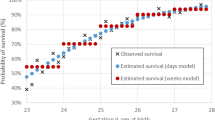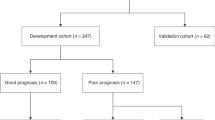Abstract
Objective:
Accurate outcome prediction is crucial for counseling parents and providing individualized treatment to extremely premature infants. We sought to improve upon existing prediction model by using a diverse population-based cohort of extremely premature live births (⩽28 weeks’ gestation) for survival and survival without severe neonatal morbidity at different times throughout the first week of life and to evaluate potential differences by race/ethnicity and maternal education.
Study design:
Retrospective cohort study of all California live births from 2007 through 2011 with linked birth, death and hospital discharge records.
Results:
A total of 6009 infants were included. In the validation data set at time of delivery, the area under the receiver-operating characteristic curve for the model containing all predictors was 0.863 for survival and 0.789 for survival without severe morbidity. The marginal probability of survival without severe neonatal morbidity of an Asian infant born to a mother with <12 years of education compared with the reference (Caucasian infant, mother with ⩾12 years of education) was −0.23 (95% confidence interval (CI) −0.31 to −0.15) for all infants at time of birth and −0.28 (95% CI −0.39 to −0.18) for infants with attempted resuscitation. Notably, no other differences by racial/ethnic category and maternal education emerged.
Conclusions:
Probabilities of survival and survival without major morbidity change rapidly throughout the first week of life. Extremely premature infants born to Asian mothers with less than a high school education appear to have a lower probability to survive without significant morbidity compared with their Caucasian peers.
This is a preview of subscription content, access via your institution
Access options
Subscribe to this journal
Receive 12 print issues and online access
$259.00 per year
only $21.58 per issue
Buy this article
- Purchase on Springer Link
- Instant access to full article PDF
Prices may be subject to local taxes which are calculated during checkout


Similar content being viewed by others
References
Higgins RD . Executive summary of the workshop on the border of viability. Pediatrics 2005; 115: 1392–1396.
Tyson JE, Parikh NA, Langer J, Green C, Higgins RD . National Institute of Child Health and Human Development Neonatal Research Network. Intensive care for extreme prematurity—moving beyond gestational age. N Engl J Med 2008; 358: 1672–1681.
Bader D, Kugelman A, Boyko V, Levitzki O, Lerner-Geva L, Riskin A et al. Risk factors and estimation tool for death among extremely premature infants: a national study. Pediatrics 2010; 125: 696–703.
Ravelli ACJ, Schaaf JM, Mol BW, Tamminga P, Eskes M, van der Post JAM et al. Antenatal prediction of neonatal mortality in very premature infants. Eur J Obstet Gynecol Reprod Biol 2014; 176: 126–131.
Tyson JE, Parikh NA, Langer J, Green C, Higgins RD. Available at https://www.nichd.nih.gov/about/org/der/branches/ppb/programs/epbo/pages/epbo_case.aspx 2008. Accessed on 8/2016.
Hornik CP, Sherwood AL, Cotten CM, Laughon MM, Clark RH, Smith PB . Daily mortality of infants born at less than 30weeks’ gestation. Early Hum Dev 2016; 96: 27–30.
Anderson JG, Baer RJ, Partridge JC, Kuppermann M, Franck LS, Rand L et al. Survival and major morbidity of extremely preterm infants: a population-based study. Pediatrics 2016; 138: 1–13.
Meadow W, Reimshisel T, Lantos J . Birth weight-specific mortality for extremely low birth weight infants vanishes by four days of life: epidemiology and ethics in the neonatal intensive care unit. Pediatrics 1996; 97: 636–643.
Mohamed MA, Nada A, Aly H . Day-by-day postnatal survival in very low birth weight infants. Pediatrics 2010; 126: e360–e366.
Ambalavanan N . Prediction of death for extremely low birth weight neonates. Pediatrics 2005; 116: 1367–1373.
Linsell L, Malouf R, Morris J, Kurinczuk JJ, Marlow N . Prognostic factors for poor cognitive development in children born very preterm or with very low birthweight. JAMA Pediatr 2015; 169: 1162–1172.
Kavvadia V, Greenough A, Dimitriou G, Hooper R . Influence of ethnic origin on respiratory distress syndrome in very premature infants. Arch Dis Child Fetal Neonatal Ed 1998; 78: F25–F28.
Haas DM, Sischy AC, McCullough W, Simsiman AJ . Maternal ethnicity influences on neonatal respiratory outcomes after antenatal corticosteroid use for anticipated preterm delivery. J Matern Fetal Neonatal Med 2010; 24: 516–520.
Ruan S, Abdel-Latif ME, Bajuk B, Lui K, Oei JL, On behalf of the NSW and the ACT Neonatal Intensive Care Units (NICUs) Group. The associations between ethnicity and outcomes of infants in neonatal intensive care units. Arch Dis Child Fetal Neonatal Ed 2012; 97: F133–F138.
Aralikatti AK, Mitra A, Denniston AKO, Haque MS, Ewer AK, Butler L . Is ethnicity a risk factor for severe retinopathy of prematurity? Arch Dis Child Fetal Neonatal Ed 2010; 95: F174–F176.
Carter BM, Holditch-Davis D . Risk factors for necrotizing enterocolitis in preterm infants. Adv Neonatal Care 2008; 8: 285–290.
Patra K, Greene M, Patel A, Meier P . Maternal education level predicts cognitive, language, and motor outcome in preterm infants in the second year of life. Am J Perinatol 2016; 33: 1–7.
Olsen IE, Groveman SA, Lawson ML, Clark RH, Zemel BS . New intrauterine growth curves based on United States data. Pediatrics 2010; 125: e214–e224.
Baer RJ, Norton ME, Shaw GM, Flessel MC, Goldman S, Currier RJ et al. Risk of selected structural abnormalities in infants after increased nuchal translucency measurement. Am J Obstet Gynecol 2014; 211: e1–e19.
Voigt M, Fusch C, Olbertz D, Hartmann K, Rochow N, Renken C et al. Analyse des Neugeborenenkollektivs der Bundesrepublik Deutschland. Geburtshilfe Frauenheilkd 2006; 66: 956–970.
Ge WJ, Mirea L, Yang J, Bassil KL, Lee SK, Shah PS et al. Prediction of neonatal outcomes in extremely preterm neonates. Pediatrics 2013; 132: e876–e885.
Medlock S, Ravelli ACJ, Tamminga P, Mol BWM, Abu-Hanna A . Prediction of mortality in very premature infants: a systematic review of prediction models. PLoS ONE 2011; 6: e23441–e23449.
Pollack MM, Koch MA, Bartel DA, Rapoport I, Dhanireddy R, El-Mohandes AA et al. A comparison of neonatal mortality risk prediction models in very low birth weight infants. Pediatrics 2000; 105: 1051–1057.
Ruiz M, Goldblatt P, Morrison J, Kukla L, Švancara J, Riitta-Järvelin M et al. Mother’s education and the risk of preterm and small for gestational age birth: a DRIVERS meta-analysis of 12 European cohorts. J Epidemiol Community Health 2015; 69: 826–833.
Auger N, Leduc L, Naimi AI, Fraser WD . Delivery at term: impact of university education by week of gestation. J Obstet Gynaecol Can 2016; 38: 118–124.
Tucker Edmonds B, Torke AM, Helft P, Wocial LD . Doctor, what would you do? An answer for patients requesting advice about value-laden decisions. Pediatrics 2015; 136: 740–745.
Steurer MA, Adams M, Bacchetti P, Schulzke SM, Roth-Kleiner M, Berger TM et al. Swiss medical centres vary significantly when it comes to outcomes of neonates with a very low gestational age. Acta Paediatr 2015; 104: 872–879.
Schmidt B, Asztalos EV, Roberts RS, Robertson CMT, Sauve RS, Whitfield MF et al. Impact of bronchopulmonary dysplasia, brain injury, and severe retinopathy on the outcome of extremely low-birth-weight infants at 18 months: results from the trial of indomethacin prophylaxis in preterms. JAMA 2003; 289: 1124–1129.
Schmidt B, Roberts RS, Davis PG, Doyle LW, Asztalos EV, Opie G et al. Prediction of late death or disability at age 5 years using a count of 3 neonatal morbidities in very low birth weight infants. J Pediatr 2015; 167: 982–986 e2.
Synnes A, Anderson PJ, Grunau RE, Dewey D, Moddemann D, Tin W et al. Predicting severe motor impairment in preterm children at age 5 years. Arch Dis Child 2015; 100: 748–753.
Acknowledgements
Efforts were funded in part by the UCSF California Preterm Birth Initiative.
Author information
Authors and Affiliations
Corresponding author
Ethics declarations
Competing interests
The authors declare no conflict of interest.
Additional information
Supplementary Information accompanies the paper on the Journal of Perinatology website
Supplementary information
Rights and permissions
About this article
Cite this article
Steurer, M., Anderson, J., Baer, R. et al. Dynamic outcome prediction in a socio-demographically diverse population-based cohort of extremely preterm neonates. J Perinatol 37, 709–715 (2017). https://doi.org/10.1038/jp.2017.9
Received:
Revised:
Accepted:
Published:
Issue Date:
DOI: https://doi.org/10.1038/jp.2017.9



